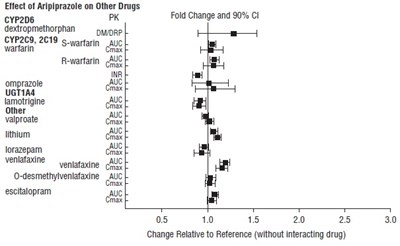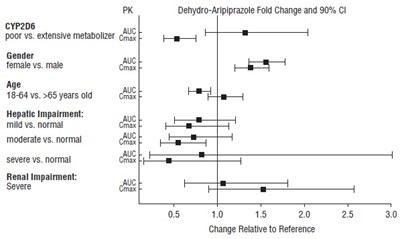Product Images Aripiprazole
View Photos of Packaging, Labels & Appearance
Product Label Images
The following 12 images provide visual information about the product associated with Aripiprazole NDC 60505-0404 by Apotex Corp., such as packaging, labeling, and the appearance of the drug itself. This resource could be helpful for medical professionals, pharmacists, and patients seeking to verify medication information and ensure they have the correct product.
Bottle-arip-os-image03.jpg - Bottle arip os image03
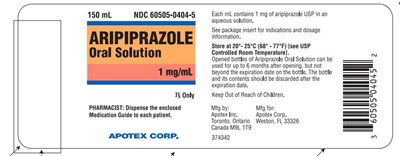
Description: Aripiprazole is an Oral Solution medication used to treat certain mental and mood disorders. It comes in a bottle of 150mL and has a concentration of 1mg/ml. It is produced by Apotex Corp and can only be obtained with a prescription from a healthcare professional. The enclosed medication guide should be dispensed to each patient. The medication should be stored at a temperature between 20-25°C and should be kept out of reach of children. Opened bottles can be used for up to 6 months after opening but discarded before the expiration date. Please see the package insert for indications and dosage information.*
Carton-arip-os-image04.jpg - Carton arip os image04

This is the description of a medication- Aripiprazole Oral Solution, manufactured by Apotex Corp. Each mL of this solution contains 1 mg of arpprazole in an aqueous solution. The dosing cup is enclosed and the package insert should be referred to for indications and dosage information. It should be kept out of reach of children and stored at controlled room temperature. The medication guide should be dispensed by the pharmacist to each patient. Opened bottles can be used up to six months after opening but not beyond the expiration date. The NDC number is 60505-0404-5.*
Fig-1 - Fig 1
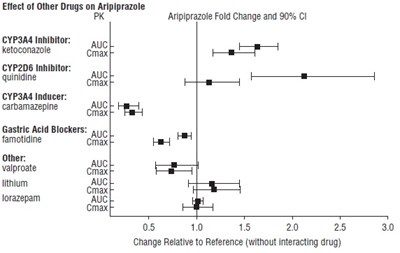
This is a table showing the effect of different drugs on aripiprazole. The drugs are categorized based on their effects on certain liver enzymes that metabolize aripiprazole, and their corresponding fold change in the drug's pharmacokinetics (PK). The table shows the drugs' impact on aripiprazole's maximum concentration (Cmax) and area under the curve (AUC). The drugs include a CYP3A4 inhibitor, a CYP2D6 inhibitor, an inducer, gastric acid blockers, and other drugs.*
Fig-2 - Fig 2
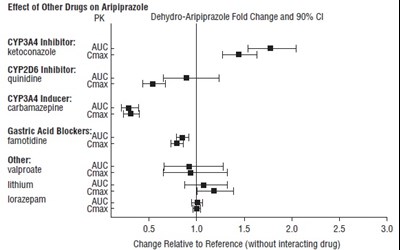
This text seems to be displaying a table or chart showing the effect of different drugs on aripiprazole, specifically in terms of how they affect its pharmacokinetics (PK). It lists certain inhibitors and inducers of specific enzymes such as CYP3A4 and CYP2D6, as well as gastric acid blockers and other drugs like valproate and lithium. The last part of the text is cut off but it appears to be showing some sort of numerical data related to changes in dehydro-aripiprazole, possibly with a graph or chart.*
Fig-4 - Fig 4
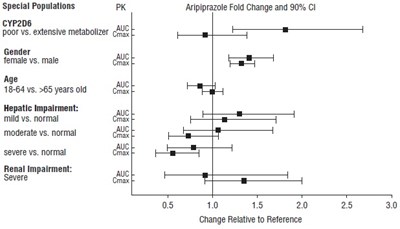
This text describes different variables that affect the behavior of drugs in special populations. These include differences in metabolism based on genetic variations of the CYP2D6 enzyme, gender, age groups, and varying degrees of hepatic and renal impairments. The text also includes data related to PK (pharmacokinetics) of drugs, such as peak concentration (Cmax) and area under the curve (AUC), as well as fold changes and confidence intervals for the drug aripiprazole.*
Fig-6 - Fig 6

This text appears to be a table showing data related to the relapse proportions of patients taking Aripiprazole versus Placebo. The table shows the number of subjects at risk and the number of patients who have relapsed over time from randomization, measured in days. However, without additional context or information, it is not possible to determine the exact nature or details of the study.*
Fig-7 - Fig 7
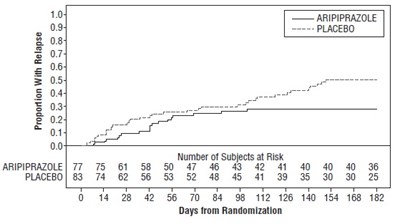
This is a chart or table that shows the proportion of subjects with relapse, using Aripiprazole vs Placebo. There are 10 columns representing time periods or intervals with values ranging from 0 to 10. There are also two rows with headings Aripiprazole and Placebo. However, without context or additional information it's not possible to interpret the results or provide further details.*
Fig-8 - Fig 8

This is a table that compares the proportion of subjects with relapse for Aripiprazole and Placebo. There are also numbers indicating the number of subjects at risk for Aripiprazole and Placebo over a period of 364 days.*
Fig-9 - Fig 9
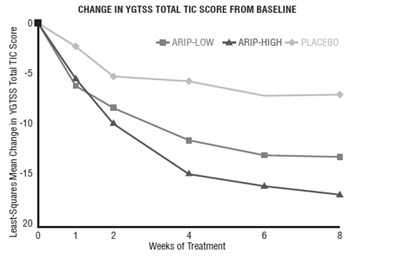
This text presents the title "Least-Squares Mean Change in YGTSS Total TIC Score" and a chart showing the change in YGTSS total TIC score from baseline for two different treatments (8-ARI-LOW and 4-ARI-HIGH) over the course of 5 weeks.*
* The product label images have been analyzed using a combination of traditional computing and machine learning techniques. It should be noted that the descriptions provided may not be entirely accurate as they are experimental in nature. Use the information in this page at your own discretion and risk.
